此篇記錄如何開啟一個新Visual Studio專案,並且將Caffe以函式庫的方式新增加入至新專案,如此一來,即可使用Caffe訓練完後之模型以及Caffe中的辨識程式來進行應用,此範例是將訓練好之人臉辨識模型以及Caffe辨識函式於新專案實現,以下有詳細的步驟說明。
開啟新的Visual Studio專案並加入Caffe函式庫。
(此處使用Visual Studio 2015為例)
開啟新專案 -> Visual C++ -> Win32主控台應用程式,並點選確定。

點選下一步。
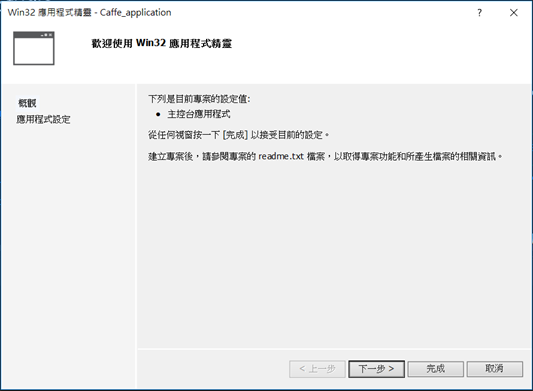
如下圖,選擇空專案,並按完成。
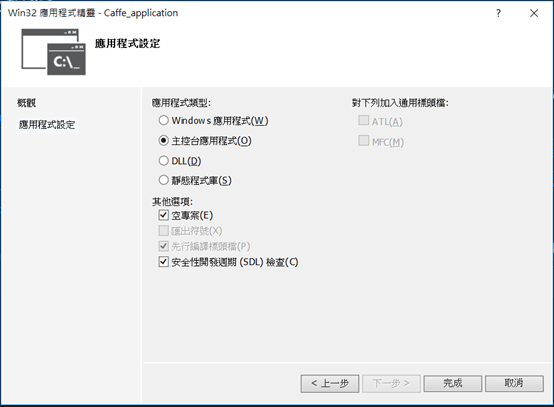
成功開啟專案後,點選專案右鍵 -> 加入 -> 新增項目即可得到下圖,並加入一個.cpp檔。
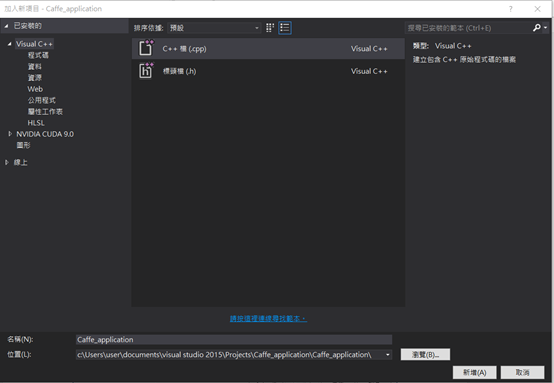
將Caffe函式庫加入新專案,點選專案右鍵 -> 屬性。
(記得組態要選擇Debug、平台選擇x64,如下圖上方)
設定C/C++ -> 一般 -> 其他Include目錄。

依照下圖位置進行include
(需視Caffe、CUDA、libraries_v140_x64_py35_1.1.0進行調整)
C:\project\caffe\scripts\build\include
C:\project\caffe\scripts\build
C:\Users\user\.caffe\dependencies\libraries_v140_x64_py35_1.1.0\libraries\include\boost-1_61
C:\Users\user\.caffe\dependencies\libraries_v140_x64_py35_1.1.0\libraries\include
C:\Program Files\NVIDIA GPU Computing Toolkit\CUDA\v8.0\include
C:\Users\user\.caffe\dependencies\libraries_v140_x64_py35_1.1.0\libraries\include\opencv
C:\project\caffe\include
C:\Users\user\.caffe\dependencies\libraries_v140_x64_py35_1.1.0\libraries\Include
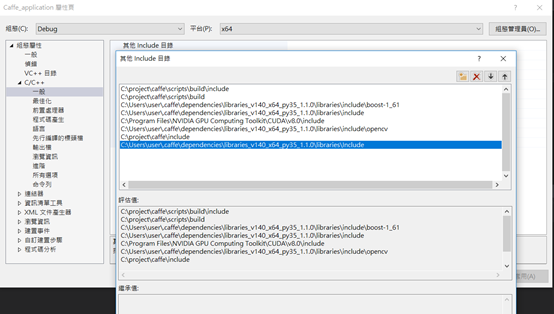
選擇前置處理器,並加入下列指令。
WIN32
_WINDOWS
CAFFE_VERSION=1.0.0
BOOST_ALL_NO_LIB
USE_LMDB
USE_LEVELDB
USE_CUDNN
USE_OPENCV
CMAKE_WINDOWS_BUILD
GLOG_NO_ABBREVIATED_SEVERITIES
GOOGLE_GLOG_DLL_DECL=__declspec(dllimport)
GOOGLE_GLOG_DLL_DECL_FOR_UNITTESTS=__declspec(dllimport)
H5_BUILT_AS_DYNAMIC_LIB=1
CMAKE_INTDIR="Debug"
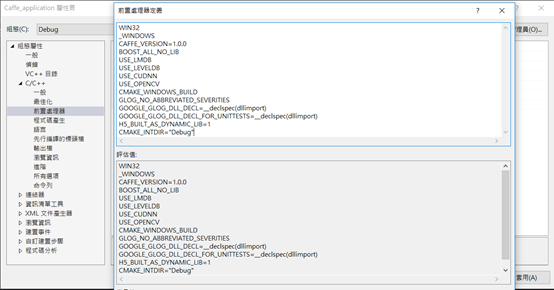
選擇連結器 -> 輸入,並加入以下指令(紅色部分前面需依照路徑修改)。
kernel32.lib
user32.lib
gdi32.lib
winspool.lib
shell32.lib
ole32.lib
oleaut32.lib
uuid.lib
comdlg32.lib
advapi32.lib
C:\project\caffe\scripts\build\lib\\Debug\caffe-d.lib
C:\project\caffe\scripts\build\lib\\Debug\caffeproto-d.lib
C:\Users\user\.caffe\dependencies\libraries_v140_x64_py35_1.1.0\libraries\lib\boost_system-vc140-mt-gd-1_61.lib
C:\Users\user\.caffe\dependencies\libraries_v140_x64_py35_1.1.0\libraries\lib\boost_thread-vc140-mt-gd-1_61.lib
C:\Users\user\.caffe\dependencies\libraries_v140_x64_py35_1.1.0\libraries\lib\boost_filesystem-vc140-mt-gd-1_61.lib
C:\Users\user\.caffe\dependencies\libraries_v140_x64_py35_1.1.0\libraries\lib\boost_chrono-vc140-mt-gd-1_61.lib
C:\Users\user\.caffe\dependencies\libraries_v140_x64_py35_1.1.0\libraries\lib\boost_date_time-vc140-mt-gd-1_61.lib
C:\Users\user\.caffe\dependencies\libraries_v140_x64_py35_1.1.0\libraries\lib\boost_atomic-vc140-mt-gd-1_61.lib
C:\Users\user\.caffe\dependencies\libraries_v140_x64_py35_1.1.0\libraries\lib\glogd.lib
C:\Users\user\.caffe\dependencies\libraries_v140_x64_py35_1.1.0\libraries\lib\gflagsd.lib
shlwapi.lib
C:\Users\user\.caffe\dependencies\libraries_v140_x64_py35_1.1.0\libraries\lib\libprotobufd.lib
C:\Users\user\.caffe\dependencies\libraries_v140_x64_py35_1.1.0\libraries\lib\caffehdf5_hl_D.lib
C:\Users\user\.caffe\dependencies\libraries_v140_x64_py35_1.1.0\libraries\lib\caffehdf5_D.lib
C:\Users\user\.caffe\dependencies\libraries_v140_x64_py35_1.1.0\libraries\lib\caffezlibd.lib
C:\Users\user\.caffe\dependencies\libraries_v140_x64_py35_1.1.0\libraries\lib\lmdbd.lib
ntdll.lib
C:\Users\user\.caffe\dependencies\libraries_v140_x64_py35_1.1.0\libraries\lib\leveldbd.lib
C:\Users\user\.caffe\dependencies\libraries_v140_x64_py35_1.1.0\libraries\lib\snappy_staticd.lib
C:\Users\user\.caffe\dependencies\libraries_v140_x64_py35_1.1.0\libraries\lib\caffezlibd.lib
C:\Program Files\NVIDIA GPU Computing Toolkit\CUDA\v8.0\lib\x64\cudart.lib
C:\Program Files\NVIDIA GPU Computing Toolkit\CUDA\v8.0\lib\x64\curand.lib
C:\Program Files\NVIDIA GPU Computing Toolkit\CUDA\v8.0\lib\x64\cublas.lib
C:\Program Files\NVIDIA GPU Computing Toolkit\CUDA\v8.0\lib\x64\cublas_device.lib
C:\Program Files\NVIDIA GPU Computing Toolkit\CUDA\v8.0\lib\x64\cudnn.lib
C:\Users\user\.caffe\dependencies\libraries_v140_x64_py35_1.1.0\libraries\x64\vc14\lib\opencv_highgui310d.lib
C:\Users\user\.caffe\dependencies\libraries_v140_x64_py35_1.1.0\libraries\x64\vc14\lib\opencv_videoio310d.lib
C:\Users\user\.caffe\dependencies\libraries_v140_x64_py35_1.1.0\libraries\x64\vc14\lib\opencv_imgcodecs310d.lib
C:\Users\user\.caffe\dependencies\libraries_v140_x64_py35_1.1.0\libraries\x64\vc14\lib\opencv_imgproc310d.lib
C:\Users\user\.caffe\dependencies\libraries_v140_x64_py35_1.1.0\libraries\x64\vc14\lib\opencv_core310d.lib
C:\Users\user\.caffe\dependencies\libraries_v140_x64_py35_1.1.0\libraries\lib\libopenblas.dll.a
C:\Users\user\Anaconda3\libs\python35.lib
C:\Users\user\.caffe\dependencies\libraries_v140_x64_py35_1.1.0\libraries\lib\boost_python-vc140-mt-gd-1_61.lib
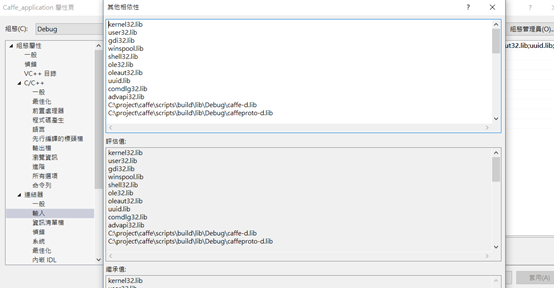
選擇連結器 -> 進階 -> 匯入程式庫,並輸入以下指令。
(需依照路徑修改)
C:/project/caffe/scripts/build/lib/Debug/classification-d.lib
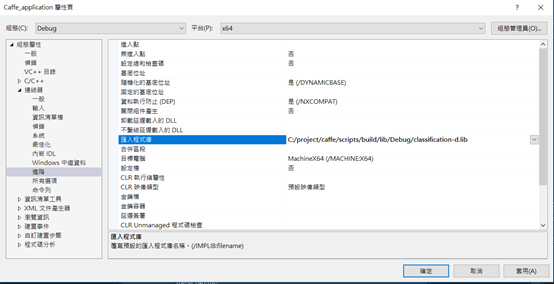
將Caffe中cpp_classification 下的dll檔複製(依造檔案路徑進行複製)。
C:\project\caffe\scripts\build\examples\cpp_classification\Debug
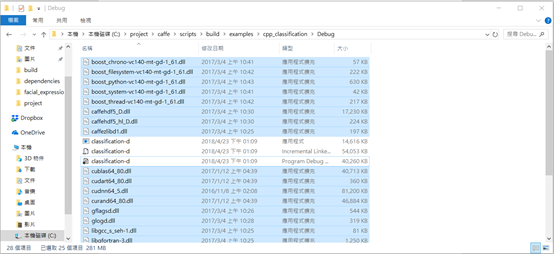
並貼至新改專案中x64/Debug中。
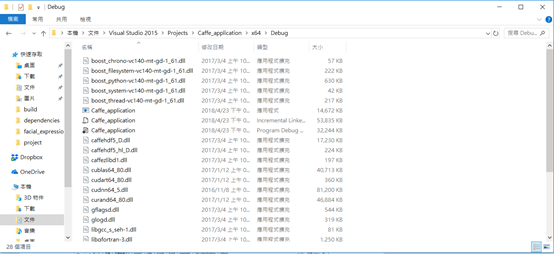
最後將Caffe專案中之classification.cpp程式碼複製至新開專案的.cpp,執行後即可得到下圖之結果,也成功將Caffe函式庫include至新專案。
(上面要選擇Debug以及x64)
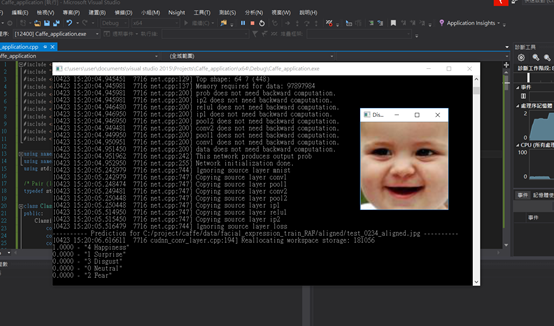
classification.cpp
(紅色部分更改為自己路徑)
#include <caffe/caffe.hpp>
#ifdef USE_OPENCV
#include <opencv2/core/core.hpp>
#include <opencv2/highgui/highgui.hpp>
#include <opencv2/imgproc/imgproc.hpp>
#endif // USE_OPENCV
#include <algorithm>
#include <iosfwd>
#include <memory>
#include <string>
#include <utility>
#include <vector>
#ifdef USE_OPENCV
using namespace caffe; // NOLINT(build/namespaces)
using std::string;
/* Pair (label, confidence) representing a prediction. */
typedef std::pair<string, float> Prediction;
class Classifier {
public:
Classifier(const string& model_file,
const string& trained_file,
const string& mean_file,
const string& label_file);
std::vector<Prediction> Classify(const cv::Mat& img, int N = 5);
private:
void SetMean(const string& mean_file);
std::vector<float> Predict(const cv::Mat& img);
void WrapInputLayer(std::vector<cv::Mat>* input_channels);
void Preprocess(const cv::Mat& img,
std::vector<cv::Mat>* input_channels);
private:
shared_ptr<Net<float> > net_;
cv::Size input_geometry_;
int num_channels_;
cv::Mat mean_;
std::vector<string> labels_;
};
Classifier::Classifier(const string& model_file,
const string& trained_file,
const string& mean_file,
const string& label_file) {
#ifdef CPU_ONLY
Caffe::set_mode(Caffe::CPU);
#else
Caffe::set_mode(Caffe::GPU);
#endif
/* Load the network. */
net_.reset(new Net<float>(model_file, TEST));
net_->CopyTrainedLayersFrom(trained_file);
CHECK_EQ(net_->num_inputs(), 1) << "Network should have exactly one input.";
CHECK_EQ(net_->num_outputs(), 1) << "Network should have exactly one output.";
Blob<float>* input_layer = net_->input_blobs()[0];
num_channels_ = input_layer->channels();
CHECK(num_channels_ == 3 || num_channels_ == 1)
<< "Input layer should have 1 or 3 channels.";
input_geometry_ = cv::Size(input_layer->width(), input_layer->height());
/* Load the binaryproto mean file. */
SetMean(mean_file);
/* Load labels. */
std::ifstream labels(label_file.c_str());
CHECK(labels) << "Unable to open labels file " << label_file;
string line;
while (std::getline(labels, line))
labels_.push_back(string(line));
Blob<float>* output_layer = net_->output_blobs()[0];
CHECK_EQ(labels_.size(), output_layer->channels())
<< "Number of labels is different from the output layer dimension.";
}
static bool PairCompare(const std::pair<float, int>& lhs,
const std::pair<float, int>& rhs) {
return lhs.first > rhs.first;
}
/* Return the indices of the top N values of vector v. */
static std::vector<int> Argmax(const std::vector<float>& v, int N) {
std::vector<std::pair<float, int> > pairs;
for (size_t i = 0; i < v.size(); ++i)
pairs.push_back(std::make_pair(v[i], static_cast<int>(i)));
std::partial_sort(pairs.begin(), pairs.begin() + N, pairs.end(), PairCompare);
std::vector<int> result;
for (int i = 0; i < N; ++i)
result.push_back(pairs[i].second);
return result;
}
/* Return the top N predictions. */
std::vector<Prediction> Classifier::Classify(const cv::Mat& img, int N) {
std::vector<float> output = Predict(img);
N = std::min<int>(labels_.size(), N);
std::vector<int> maxN = Argmax(output, N);
std::vector<Prediction> predictions;
for (int i = 0; i < N; ++i) {
int idx = maxN[i];
predictions.push_back(std::make_pair(labels_[idx], output[idx]));
}
return predictions;
}
/* Load the mean file in binaryproto format. */
void Classifier::SetMean(const string& mean_file) {
BlobProto blob_proto;
ReadProtoFromBinaryFileOrDie(mean_file.c_str(), &blob_proto);
/* Convert from BlobProto to Blob<float> */
Blob<float> mean_blob;
mean_blob.FromProto(blob_proto);
CHECK_EQ(mean_blob.channels(), num_channels_)
<< "Number of channels of mean file doesn't match input layer.";
/* The format of the mean file is planar 32-bit float BGR or grayscale. */
std::vector<cv::Mat> channels;
float* data = mean_blob.mutable_cpu_data();
for (int i = 0; i < num_channels_; ++i) {
/* Extract an individual channel. */
cv::Mat channel(mean_blob.height(), mean_blob.width(), CV_32FC1, data);
channels.push_back(channel);
data += mean_blob.height() * mean_blob.width();
}
/* Merge the separate channels into a single image. */
cv::Mat mean;
cv::merge(channels, mean);
/* Compute the global mean pixel value and create a mean image
* filled with this value. */
cv::Scalar channel_mean = cv::mean(mean);
mean_ = cv::Mat(input_geometry_, mean.type(), channel_mean);
}
std::vector<float> Classifier::Predict(const cv::Mat& img) {
Blob<float>* input_layer = net_->input_blobs()[0];
input_layer->Reshape(1, num_channels_,
input_geometry_.height, input_geometry_.width);
/* Forward dimension change to all layers. */
net_->Reshape();
std::vector<cv::Mat> input_channels;
WrapInputLayer(&input_channels);
Preprocess(img, &input_channels);
net_->Forward();
/* Copy the output layer to a std::vector */
Blob<float>* output_layer = net_->output_blobs()[0];
const float* begin = output_layer->cpu_data();
const float* end = begin + output_layer->channels();
return std::vector<float>(begin, end);
}
/* Wrap the input layer of the network in separate cv::Mat objects
* (one per channel). This way we save one memcpy operation and we
* don't need to rely on cudaMemcpy2D. The last preprocessing
* operation will write the separate channels directly to the input
* layer. */
void Classifier::WrapInputLayer(std::vector<cv::Mat>* input_channels) {
Blob<float>* input_layer = net_->input_blobs()[0];
int width = input_layer->width();
int height = input_layer->height();
float* input_data = input_layer->mutable_cpu_data();
for (int i = 0; i < input_layer->channels(); ++i) {
cv::Mat channel(height, width, CV_32FC1, input_data);
input_channels->push_back(channel);
input_data += width * height;
}
}
void Classifier::Preprocess(const cv::Mat& img,
std::vector<cv::Mat>* input_channels) {
/* Convert the input image to the input image format of the network. */
cv::Mat sample;
if (img.channels() == 3 && num_channels_ == 1)
cv::cvtColor(img, sample, cv::COLOR_BGR2GRAY);
else if (img.channels() == 4 && num_channels_ == 1)
cv::cvtColor(img, sample, cv::COLOR_BGRA2GRAY);
else if (img.channels() == 4 && num_channels_ == 3)
cv::cvtColor(img, sample, cv::COLOR_BGRA2BGR);
else if (img.channels() == 1 && num_channels_ == 3)
cv::cvtColor(img, sample, cv::COLOR_GRAY2BGR);
else
sample = img;
cv::Mat sample_resized;
if (sample.size() != input_geometry_)
cv::resize(sample, sample_resized, input_geometry_);
else
sample_resized = sample;
cv::Mat sample_float;
if (num_channels_ == 3)
sample_resized.convertTo(sample_float, CV_32FC3);
else
sample_resized.convertTo(sample_float, CV_32FC1);
cv::Mat sample_normalized;
cv::subtract(sample_float, mean_, sample_normalized);
/* This operation will write the separate BGR planes directly to the
* input layer of the network because it is wrapped by the cv::Mat
* objects in input_channels. */
cv::split(sample_normalized, *input_channels);
CHECK(reinterpret_cast<float*>(input_channels->at(0).data)
== net_->input_blobs()[0]->cpu_data())
<< "Input channels are not wrapping the input layer of the network.";
}
int main() {
string model_file = "C:/project/caffe/data/facial_expression_train_RAF-3/lenet_deploy.prototxt";
string trained_file = "C:/project/caffe/data/facial_expression_train_RAF-3/snapshot_lenet/_iter_10000.caffemodel";
string mean_file = "C:/project/caffe/data/facial_expression_train_RAF-3/mean.binaryproto";
string label_file = "C:/project/caffe/data/facial_expression_train_RAF-3/synset_words.txt";
string file = "C:/project/caffe/data/facial_expression_train_RAF-3/aligned/test_0234_aligned.jpg";
Classifier classifier(model_file, trained_file, mean_file, label_file); //loading training model
std::cout << "---------- Prediction for "
<< file << " ----------" << std::endl;
cv::Mat img = cv::imread(file, -1);
CHECK(!img.empty()) << "Unable to decode image " << file;
std::vector<Prediction> predictions = classifier.Classify(img);
/* Print the top N predictions. */
for (size_t i = 0; i < predictions.size(); ++i) {
Prediction p = predictions[i];
std::cout << std::fixed << std::setprecision(4) << p.second << " - \""
<< p.first << "\"" << std::endl;
}
imshow("Display window", img);
cvWaitKey(0);
}
#else
int main(int argc, char** argv) {
LOG(FATAL) << "This example requires OpenCV; compile with USE_OPENCV.";
}
#endif // USE_OPENCV
#如有問題歡迎留言討論



 留言列表
留言列表


